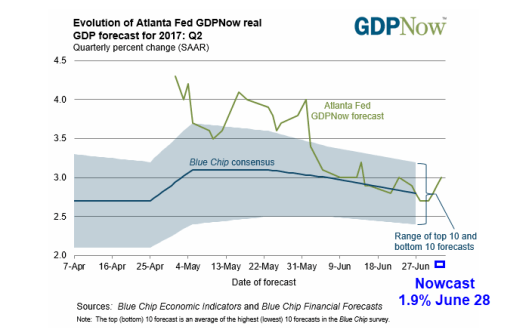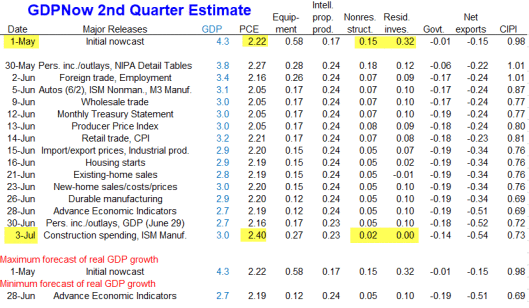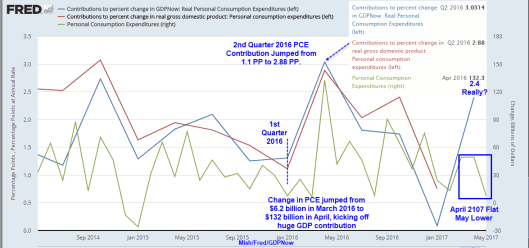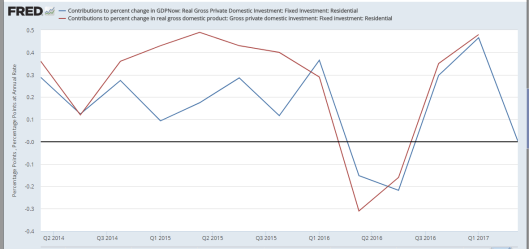On Monday, following construction spending and ISM reports, GDPNow upped its estimate of second-quarter GDP from 2.7% to 3.0%.
I am increasingly confident that its estimate is way too high. Let’s take a look at my reasons starting with the latest GDPNow forecast.
GDPNow Latest forecast: 3.0 percent — July 3, 2017

"The GDPNow model forecast for real GDP growth (seasonally adjusted annual rate) in the second quarter of 2017 is 3.0 percent on July 3, up from 2.7 percent on June 30. The forecasts of second-quarter real nonresidential structures and residential investment declined from 1.6 and 2.5 percent to 0.6 and 0.1 percent, respectively, after this morning’s construction spending release from the U.S. Census Bureau. The forecasts of second-quarter real consumer spending and nonresidential equipment investment growth increased from 3.1 and 3.0 percent to 3.5 and 4.7 percent, respectively, after this morning’s Manufacturing ISM Report On Business from the Institute for Supply Management."
Soft Data Silliness
GDPNow, as does the Federal Reserve Bank of New York Nowcast, places way too much faith in soft data reports that are not worth a hoot.
On July 3, I commented ISM vs Markit PMI Divergence Widens Again: Believe Markit.
Had GDPNow been following Markit’s PMI instead of ISM it would not have added 0.3 percentage points to its forecast.
Construction Bump
GDPNow started off its initial forecast on May 1, at an unbelievable 4.3% largely due to huge construction spending revisions for the fisrt quarter.
Although actual hard data never matched that initial forecast, the model only corrected slightly.
Contributions to GDPNow Forecast

On May 1, GDPNow estimated Personal Consumption Expenditures (PCE) as adding 2.22 percentage points to second quarter GDP.
Total the numbers horizontally to arrive at the GDP forecast in blue.
Despite poor retail sales figures and terrible auto sales, the GDPNow model actually added to its PCE contribution estimate.
GDPNOW PCE Contribution vs Historical PCE Contribution vs Change in PCE

The second quarter of 2017 looks nothing like second quarter of 2016. Retail spending reports have been weak and yesterday we had another weak auto report. Ford and GM sales in June were down four five percent from a year ago and essentially flat from May.
There is no sign of a huge rebound in PCE.
Residential Construction

GDPNow has a good track record of estimating residential construction contribution to GDP. Its forecast is headed in the right direction.
However, I have both residential and commercial subtracting from second quarter GDP based on the latest construction spending report. Fred does not have GDPNow’s nonresidential data, so I can offer no chart of historical performance.
Mish Estimate
I have PCE adding 0 to 1.0 percentage points to second quarter GDP. A negative number would not be surprising. I have construction and residential investment subtracting 0.2 percentage points each.
I have construction and residential investment subtracting 0.2 percentage points each.
That would put my estimate 1.8 to 2.8 percentage points lower than GDPNow (a range of 0.2 to 1.2).
I also have considerable doubts about Change in Private Inventories (CIPI) as auto inventories are stacking up at what should be decreasing valuations in my way of thinking.
I suspect the BEA will see things differently. But if CIPI is negative, and my other estimates are correct, we will see negative second quarter GDP.
One more month of data remains, and construction spending can be revised in any direction.
To pick as a single number for now, I will estimate second quarter GDP at 0.8%.
This material is based upon information that Sitka Pacific Capital Management considers reliable and endeavors to keep current, Sitka Pacific Capital Management does not assure that this material is accurate, current or complete, and it should not be relied upon as such.
Recommended Content
Editors’ Picks

EUR/USD dips below 1.1000 as Trump authorizes 90-day pause on tariffs
EUR/USD retreated below the 1.1000 mark on headlines indicating that United States President Donald Trump authorized a 90-day pause on non-retaliating countries. The pause applies to reciprocal and 10% tariffs, effective immediately, according to a Truth Social post. FOMC Minutes coming up next.

GBP/USD eases further on tariffs pause announcement, USD still weak
GBP/USD's correction seems to have met a decent contention around the 1.2750 zone so far on Wednesday, as investors continue to assess the ongoing US-China trade war ahead of the release of the FOMC Minutes. Pause in 10% and reciprocal tariffs lifted the mood.

Gold recedes to $3,050 on Trump's headlines
Gold prices now give away part of their advance and revisit the $3,050 zone per troy ounce after President Trump announced a 90-day pause on reciprocal and 10% tariffs.

Fed Minutes to offer clues on rate cut outlook amid tariff uncertainty
The eagerly awaited minutes from the US Fed’s March 18-19 monetary policy meeting are set for release on Wednesday at 18:00 GMT. During the gathering, policymakers agreed to keep the Fed Funds Target Range (FFTR) unchanged at 4.25%-4.50%.

Tariff rollercoaster continues as China slapped with 104% levies
The reaction in currencies has not been as predictable. The clear winners so far remain the safe-haven Japanese yen and Swiss franc, no surprises there, while the euro has also emerged as a quasi-safe-haven given its high liquid status.

The Best brokers to trade EUR/USD
SPONSORED Discover the top brokers for trading EUR/USD in 2025. Our list features brokers with competitive spreads, fast execution, and powerful platforms. Whether you're a beginner or an expert, find the right partner to navigate the dynamic Forex market.